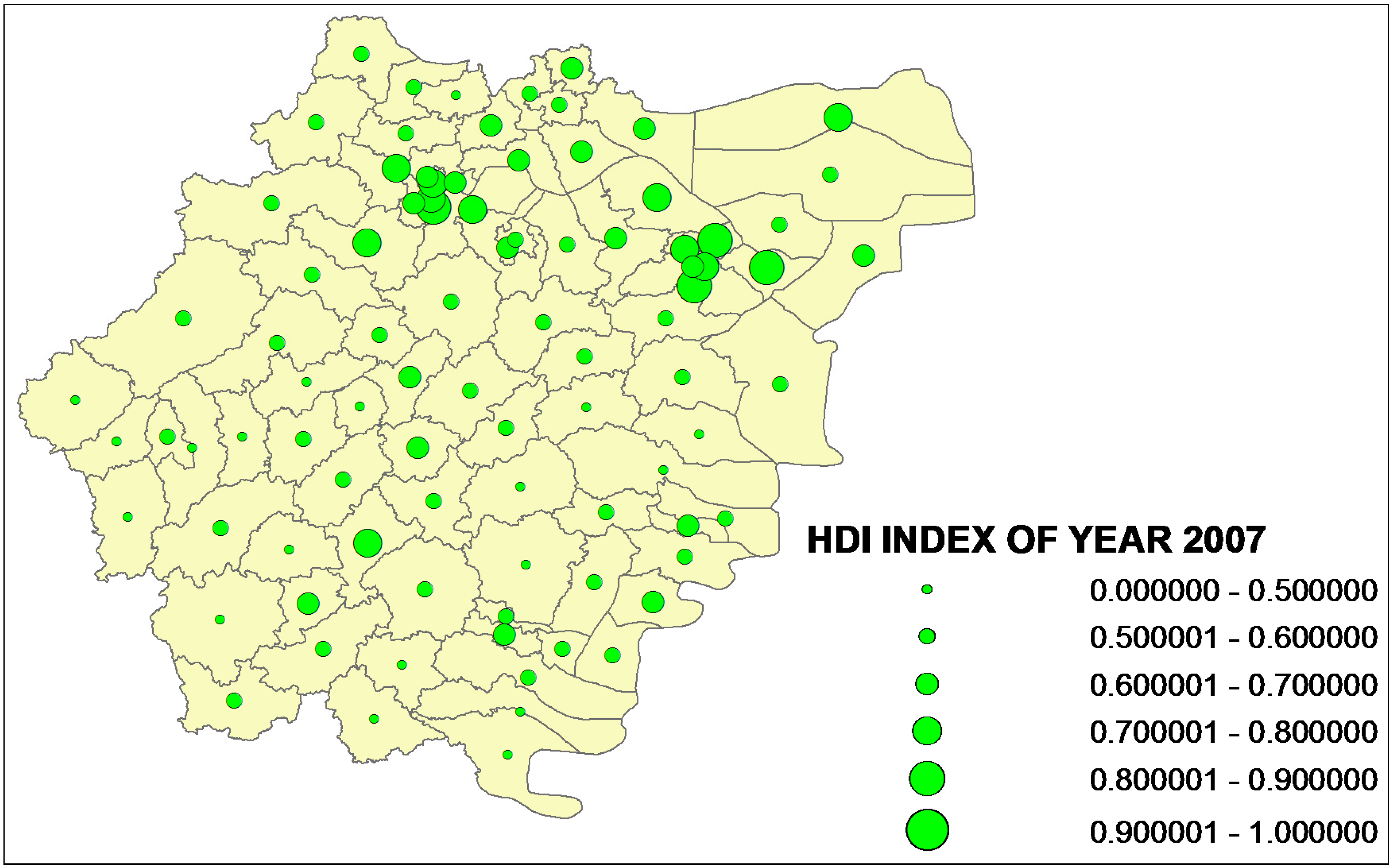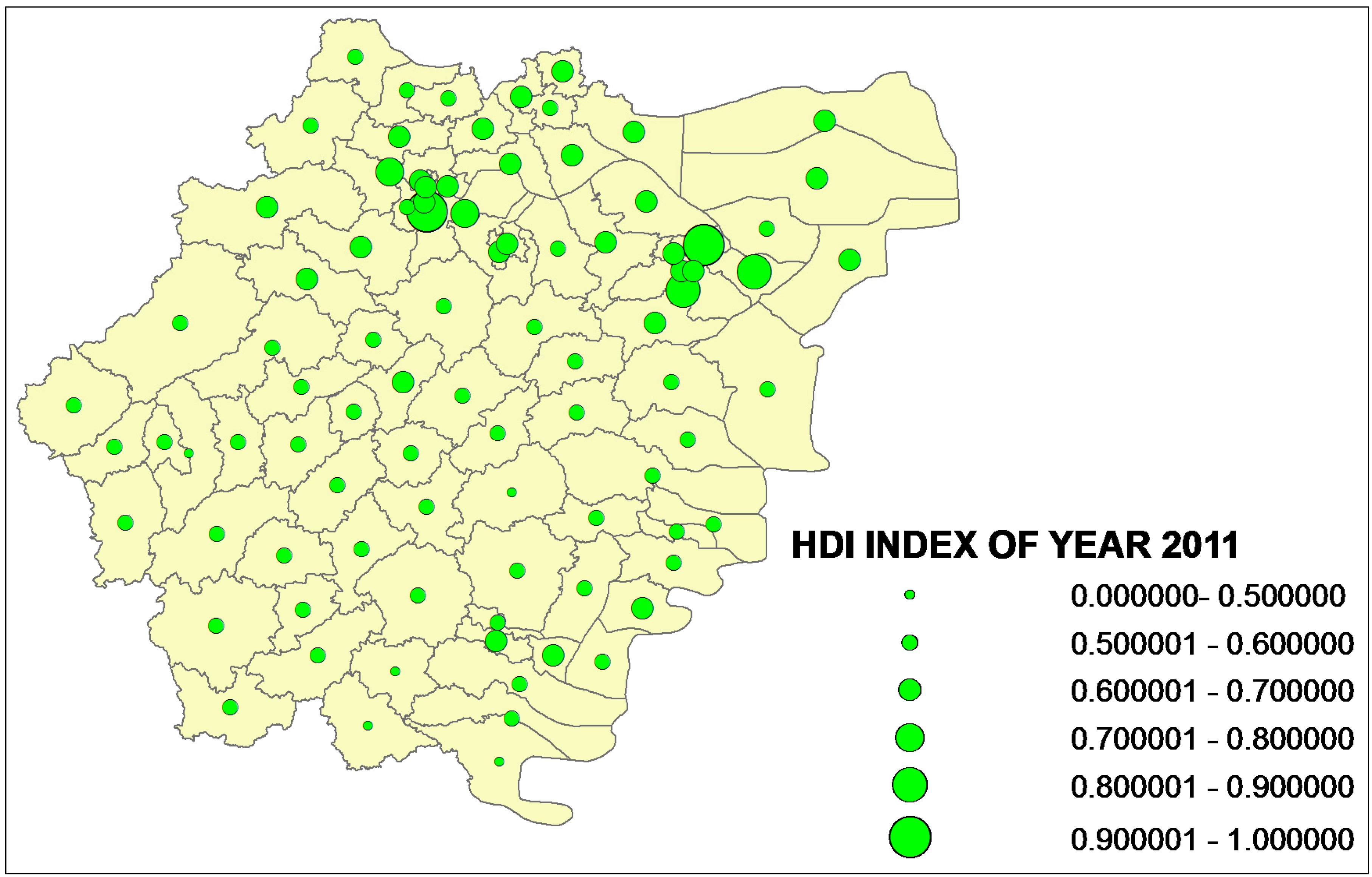Spatial Variation of Regional Sustainable Development and its Relationship to the Allocation of Science and Technology Resources
Abstract
:1. Introduction
2. Literature Review
2.1. Resource Allocation and Sustainable Development
2.2. Science and Technology Resource Allocation and Sustainable Development
2.3. Evaluation Index of Sustainable Development
2.4. Research Comment
3. Spatial Variation of Regional Sustainable Development


| Year | Global Moran’s I | Z Score |
|---|---|---|
| 2007 | 0.568804 | 9.998164 |
| 2008 | 0.568804 | 9.998164 |
| 2009 | 0.590226 | 10.399656 |
| 2010 | 0.603443 | 10.705256 |
| 2011 | 0.605040 | 10.766186 |
4. Modeling
4.1. Hypothesis
4.2. Variables and Evaluation Index
| Variable | Measurement Index |
|---|---|
| sustainable development | human development index(HDI) |
| scientific and technological personnel | technical personnel number per ten thousand people |
| popularization of science and technology | Popularization of science and technology funding per capita |
| labor education | proportion of education funding in local fiscal expenditure budget |
| regional total funding of science and technology | proportion of science and technology investment in GDP |
| government financial support | proportion of science and technology funding in fiscal expenditure |
| enterprise research and development enthusiasm | proportion of enterprise technology research and development fee in main business income |
| economic level | per capita GDP |
| infrastructure construction | informationalized level |
| industrial structure | proportion of high-tech industry |
4.3. Econometric Model
4.4. Data
5. Results and Discussion
5.1. Results of Empirical Analysis
| Variable | Coefficient | p-value | |
|---|---|---|---|
| human resource | PER | 0.1909008 | 0.000 |
| POR | 0.0648423 | 0.000 | |
| LE | 0.0202836 | 0.000 | |
| financial resource | FUN | 0.0616795 | 0.000 |
| FIN | 0.1886012 | 0.888 | |
| ERD | 0.1653552 | 0.000 | |
| environment resource | ECO | −0.0001678 | 0.004 |
| INF | 0.0884934 | 0.000 | |
| IND | 0.4235742 | 0.000 | |
| con | −34.08153 | 0.000 | |
| obs | 450 | ||
| Durbin-Watson | 2.5367 | ||
5.2. Discussion
6. Conclusions
Acknowledgments
Author Contributions
Conflicts of Interest
References
- Schilling, M.; Chiang, L. The effect of natural resources on a sustainable development policy: The approach of non-sustainable externalities. Energ. Pol. 2011, 39, 990–998. [Google Scholar] [CrossRef]
- Lu, C.L.; Hu, J.S. Problems and countermeasures of resources allocation in rural areas based on sustainable development. J. Northwest Agric. For. Univ. (Soc. Sci. Ed.) 2012, 6, 32–36. [Google Scholar]
- Higgins, P. From sustainable development to carbon control: Urban transformation in Hong Kong and London. J. Clean. Prod. 2013, 50, 56–67. [Google Scholar] [CrossRef]
- Fürsta, C.; Helming, K.; Lorz, C.; Müller, F.; Verburg, P.H. Integrated land use and regional resource management-across-disciplinary dialogue on future perspectives for a sustainable development of regional resources. J. Environ. Manag. 2013, 127, S1–S5. [Google Scholar]
- Wang, C.L. The Study on the Dynamic Evaluation of Mineral Resources Based on Sustainable Development Theory. Ph.D. Dissertation, Central South University, Changsha, China, 2013; p. 10. [Google Scholar]
- Chen, S.Y. Sustainable development trend forecast theory and method of water resources system based on variable sets. J. Dalian Univ. Technol. 2013, 1, 108–113. [Google Scholar]
- Wei, L.B.; Liu, Y.J. Study on relative carrying capacity of resources and sustainable development of Taiyuan. China Popul. Resour. Environ. 2013, 11, 54–57. [Google Scholar]
- Sun, B.F.; Li, J.H. Science and technology resources allocation research based on the sustainable development. Soc. Sci. Front 2001, 5, 36–39. [Google Scholar]
- Jiang, Z.H.; Liu, Z. Science and technology progress, sustainable development and industrial structure adjustment model of ecological city. Sci. Sci. Manag. Sci Technol. 2001, 4, 58–60. [Google Scholar]
- Cheng, P. Set up sustainable innovation of science and technology appraise system to put forward sustainable development. Wuhan Univ. J. (Soc. Sci.) 2003, 56, 307–312. [Google Scholar]
- Wu, Z.Z. Science and technology innovation is the source and power of urban sustainable development in the 21st century. China Soft Sci. 2006, 9, 13–16. [Google Scholar]
- Szymanska, D.; Miszczuk, J.C. Endogenous resources utilization of rural areas in shaping sustainable development in Poland. Renew. Sustain. Energy Rev. 2011, 15, 1497–1501. [Google Scholar] [CrossRef]
- Sedlacek, S. The role of universities in fostering sustainable development at the regional level. J. Clean. Prod. 2013, 48, 74–84. [Google Scholar] [CrossRef]
- Tripon, A. Innovative technology for sustainable development of human resource using non-formal and informal education. Proced. Technol. 2014, 12, 598–603. [Google Scholar] [CrossRef]
- Zhang, Z.Q.; Xu, G.D.; Xu, Z.M. Sustainable development evaluation index, method and application research. J. Glaciol. Geocryol. 2002, 24, 344–359. [Google Scholar]
- Chen, D.J.; Li, P.P.; Du, J.; Liu, L.J.; Xu, X.Y. Human development index based on the ecological footprint and the evaluation of the sustainable development. China Soft Sci. 2006, 6, 96–103. [Google Scholar]
- Zhang, Y. The ecological footprint change and the impact on the sustainable development of Beijing. J. China Univ. Geosci. (Soc. Sci. Ed.) 2006, 6, 47–55. [Google Scholar]
- Zhang, L.Q.; Chen, S.P.; Rong, H.F.; Xu, X.W. Dynamic calculation and analysis of sustainable development of Chizhou City in Anhui province during 2001–2010. Geogr. Res. 2012, 31, 439–449. [Google Scholar]
- Chansarn, S. Assessing the Sustainable Development of Thailand. Proced. Environ. Sci. 2013, 17, 611–619. [Google Scholar] [CrossRef]
- Cairns, R.; Martinet, V. An environmental-economic measure of sustainable development. Eur. Econ. Rev. 2014, 3, 1–14. [Google Scholar]
- Pires, S.M.; Fidélis, T.; Ramos, T.B. Measuring and comparing local sustainable development through common indicators: Constraints and achievements in practice. Cities 2014, 39, 1–9. [Google Scholar] [CrossRef]
- Bravo, G. The Human Sustainable Development Index: New calculations and a first critical analysis. Ecol. Indic. 2014, 37, 145–150. [Google Scholar] [CrossRef]
- Xu, J.G. The regional resource allocation ability of science and technology in our country. China Soft Sci. 2002, 9, 98–100. [Google Scholar]
- Fan, F.; Du, D.B.; Li, H. Regional science and technology resource allocation efficiency and comparative advantage analysis. Stud. Sci. Sci. 2012, 30, 1198–1206. [Google Scholar]
- Ames, E.; Rosenberg, N. Changing technological leadership and industrial growth. Econ. J. 1963, 73, 13–31. [Google Scholar] [CrossRef]
© 2014 by the authors; licensee MDPI, Basel, Switzerland. This article is an open access article distributed under the terms and conditions of the Creative Commons Attribution license (http://creativecommons.org/licenses/by/3.0/).
Share and Cite
Wu, J.; Wu, G.; Zhou, Q.; Li, M. Spatial Variation of Regional Sustainable Development and its Relationship to the Allocation of Science and Technology Resources. Sustainability 2014, 6, 6400-6417. https://doi.org/10.3390/su6096400
Wu J, Wu G, Zhou Q, Li M. Spatial Variation of Regional Sustainable Development and its Relationship to the Allocation of Science and Technology Resources. Sustainability. 2014; 6(9):6400-6417. https://doi.org/10.3390/su6096400
Chicago/Turabian StyleWu, Jian, Guangdong Wu, Qing Zhou, and Mi Li. 2014. "Spatial Variation of Regional Sustainable Development and its Relationship to the Allocation of Science and Technology Resources" Sustainability 6, no. 9: 6400-6417. https://doi.org/10.3390/su6096400
APA StyleWu, J., Wu, G., Zhou, Q., & Li, M. (2014). Spatial Variation of Regional Sustainable Development and its Relationship to the Allocation of Science and Technology Resources. Sustainability, 6(9), 6400-6417. https://doi.org/10.3390/su6096400




